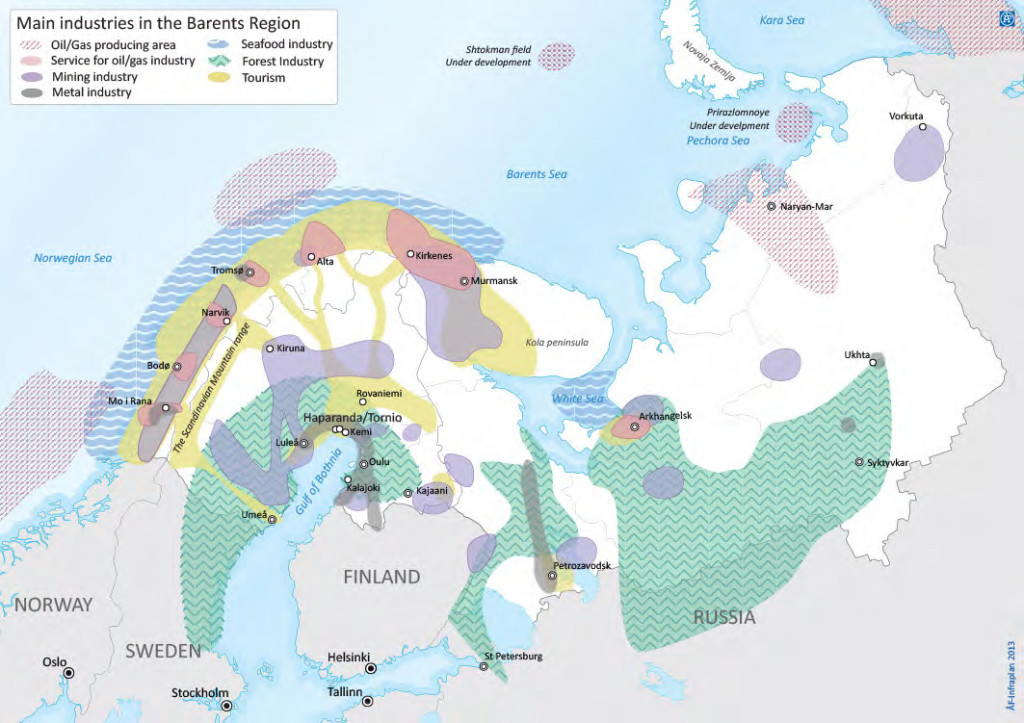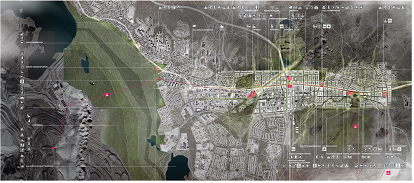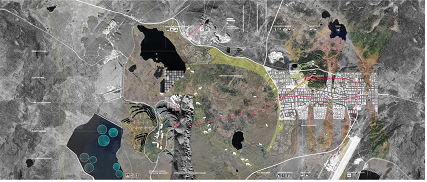This column aims at investigating harbours in a landscape perspective, which means extending our view beyond the delimited harbour area towards the surrounding landscape of which the harbour is a constitutive part. Let us look at an extreme location on our planet, the Norwegian port of Narvik, and at an unexpectedly human-made landscape in a region which is known as almost empty of human settlement, the European Arctic. In actual fact the port and the city of Narvik are part of a large Arctic landscape which is under astonishing transformation – so strongly driven by industrial activity and so overwhelmingly huge that I tend to call it the Arctic landscape machine.
The port of Narvik is composed by three waterfront sections, the central port area with piers, a deep-water port with intermodal facilities, and the bulk port of the Swedish state company LKAB. The first section is classical, the second so important that in 2005 Narvik port was labeled the ‘Motorways of the Sea’ in the EU system, and the third is simply the injector of Swedish ore to the global building market. Narvik is LKAB’s biggest port with a capacity of almost 20 million tons per year. Because of the Gulf stream, it is ice-free all year round and sufficiently deep for ocean-going vessels. Its advanced automation facilities manage to unload an ore train of 68 wagons in less than six minutes. Railways connect the port to the Swedish mining districts of Kiruna and Gällivare. This region is one of the few left on our planet where natural resources, mainly iron ore, seem to be inexhaustible. Swedish mining having developed since a century on a rather slow pace, today turns this part of the Arctic into a booming hot spot of the global economy, into a meeting place for international engineers and businessmen with dollars in the eyes. And mining turns this landscape upside down, in terms of topography, human settlement, culture. As the mining causes considerable slagheaps on the one hand and considerable subsidence on the other, large parts of the landscape have been reshaped over the last decades. Currently LKAB finances the dislocation of the entire Kiruna city centre because the ore mines are to be extended underneath it, causing subsidence, and the city centre will crack – so off it goes. International architecture competitions for a new city centre and a new town hall have been judged in 2013, and building starts right away as mining goes on at increased speed. The Swedish firm White Architects together with the Norwegian practice of Hellsten+Ghilardi is in charge of the city centre rebuilding, and Danish architect Henning Larsen will erect the new town hall. This is pioneer work – how to build the city in the middle of a shifting terrain, not knowing what ground the landscape machine will pull upside down next?
Looking at the Scandinavian Arctic in a landscape perspective makes sense as this site is deeply shaped by both natural processes and human practices and will continue to be subject to them. Natural processes generated this site some 10.000 years ago, when the ice was melting at the end of the last ice age, liberating the Arctic bedrock and creating a partly hilly, partly low lying water landscape from the rivulets and rubbles under the eroding effect of the melting ice, followed by vegetation benefitting from raising temperatures and fertile soils. Eventually, humans colonised the site as nomads, the Sami, and started to cultivate the land through their practices – since then natural processes have not been the only landscaping forces.
With mining industry starting ore exploitation at the turn of 19th to 20th century, Kiruna turned into an urban site, installed close to the mining facilities. Sedentary practices completed the nomadic way of living, humans shaped the land through settlement and urban culture. In the course of 20th century, deep mining procedures brought about heavy topographical changes paralleled by an intensified city development and the consolidation of regional infrastructures like rail, road, port and airport. The accelerated development of a globalising market since the turn of 21st century finally provided the mining industry with profitable business all over the world, generating the situation we are facing now: ore is to be extracted from deeper down, and the city, situated on top of future extraction galleries, is asked to shift to where no mining is planned, at least to date.
New Kiruna city centre, state projected for 2033. (Source: White/ Hellsten+Ghilardi, 2012)
New Kiruna city centre, state projected for 2100. (Source: White/ Hellsten+Ghilardi, 2012)
The expected global warming of the coming decennia however does not only bring natural processes back on stage but also enhances human practices (and one does not need to speculate to explain the global warming itself as an effect of human practices): the exploitation of ore and other natural resources promises an even more profitable business when new shipping routes across the Barents Sea will be opened due to the melting down of the North Pole’s ice. This might cause completely unpredictable effects on this planet, and in front of this uncertain future, mining activities are almost a predictable certainty at plots still unsuspected today, complete with an enhanced infrastructure to connect Kiruna and Narvik with the hubs of the global market. In the coming decennia, global players will develop the Arctic landscape machine in ways we are not able to foresee, presenting a precarious situation to city development. Only a design project taking into account this bigger landscape picture is able to deliver a realistic fundament for a city development under the conditions of precariousness.
And one might well ask, in front of the seemingly inexhaustible ore grounds, where are the limits of exploitation for the sake of the Arctic landscape and their inhabitants?
 Raw materials and main industries in the Barents region. (Source: Joint Barents Transport Plan, 2009)
Raw materials and main industries in the Barents region. (Source: Joint Barents Transport Plan, 2009)
References
https://www.portofnarvik.com
https://www.lkab.com/en/About-us/Overview/Operations-Areas/Narvik/
https://www.arkitekt.se/s70476
https://www.white.se/projekt/268
https://www.ghilardihellsten.com/article/?projectid=169
Head Image: Mining subsidence zone in front of the Kiruna city centre. (Photo: Lisa Diedrich, 2102)

